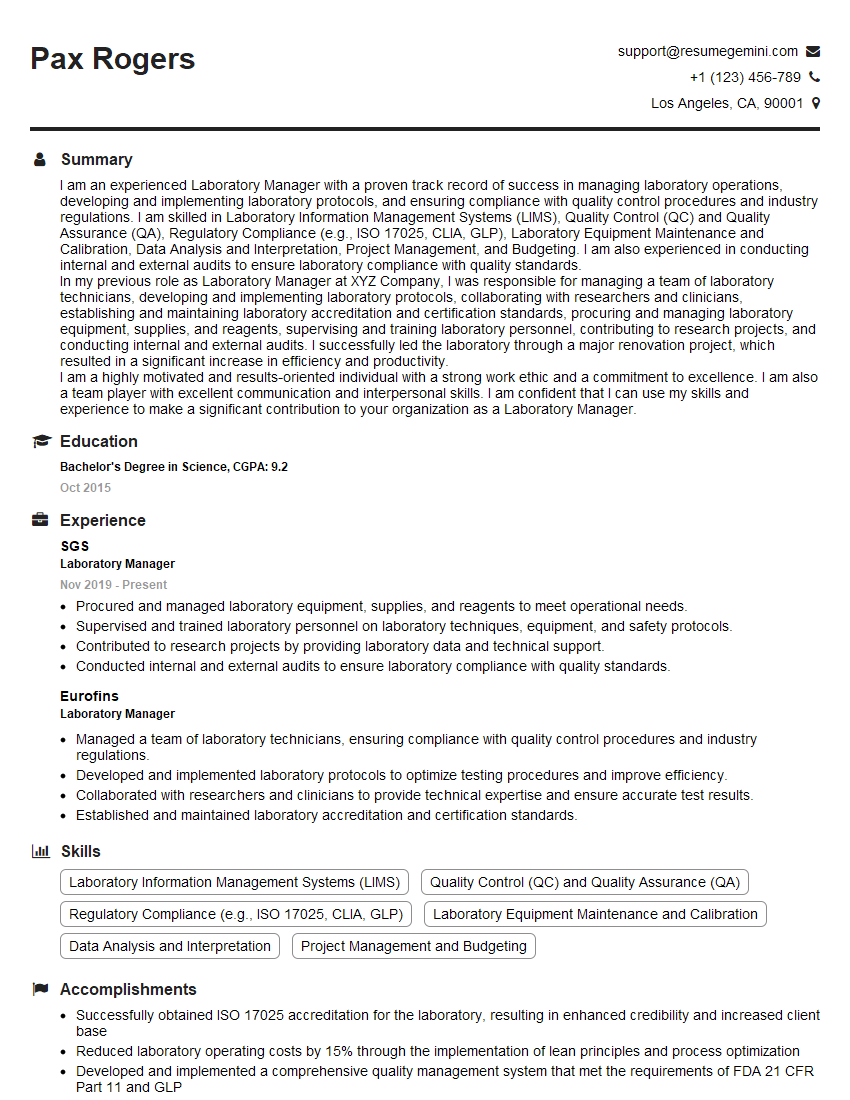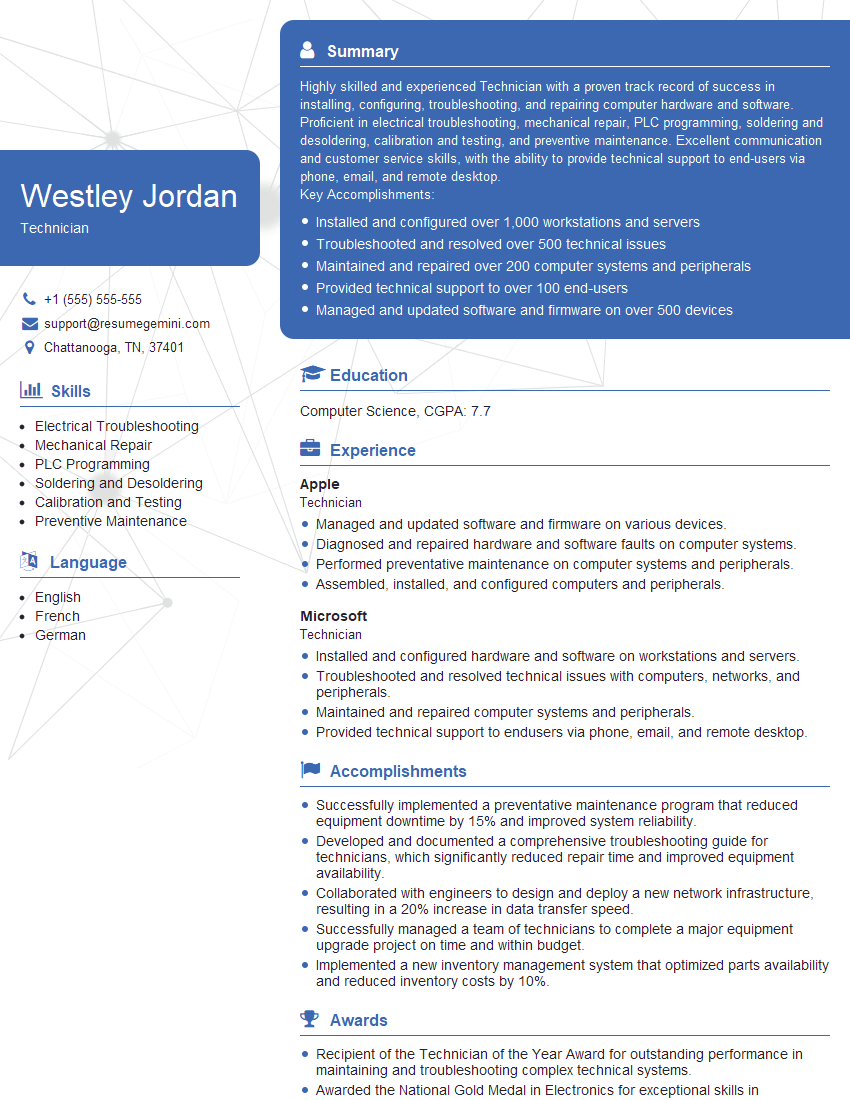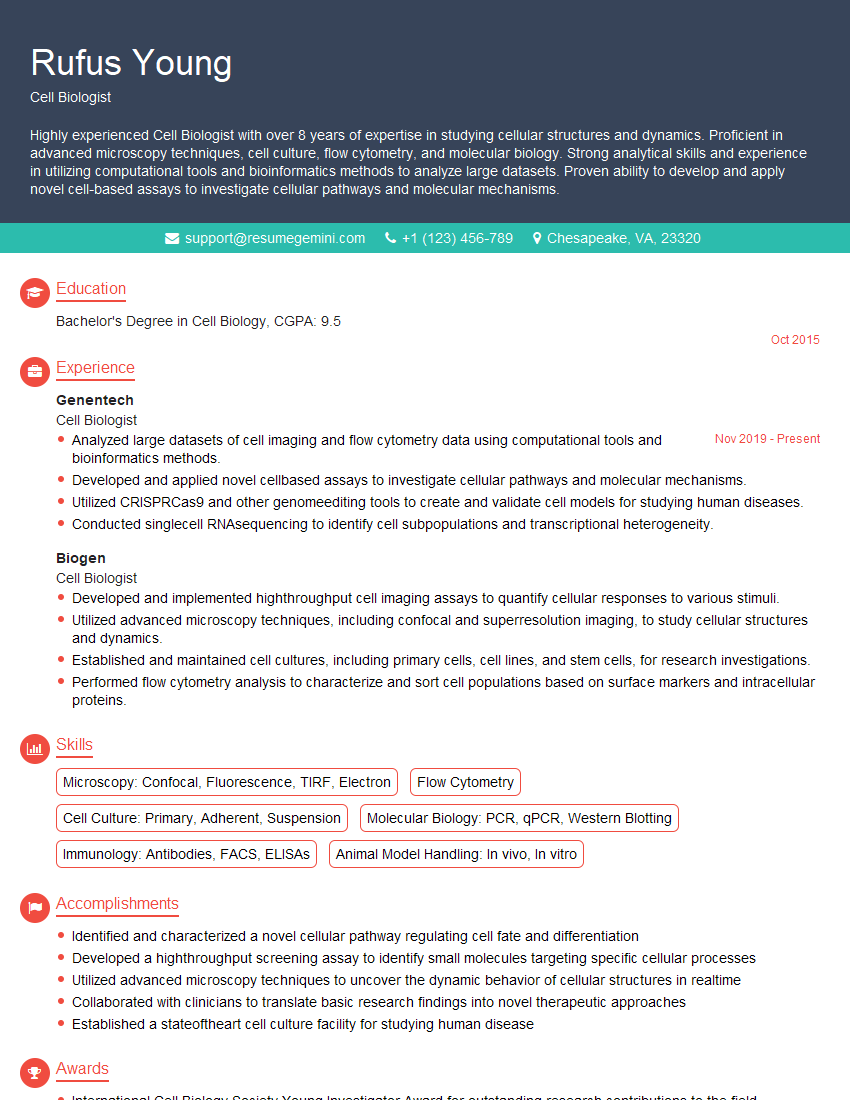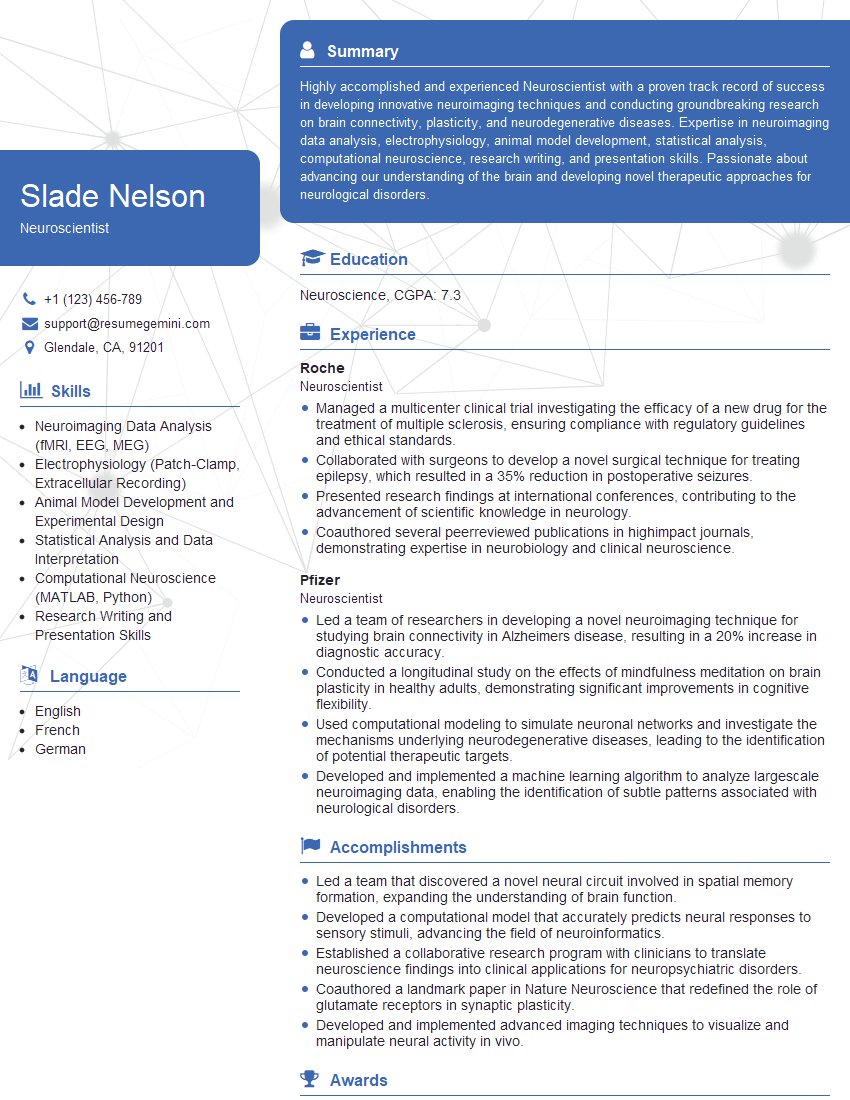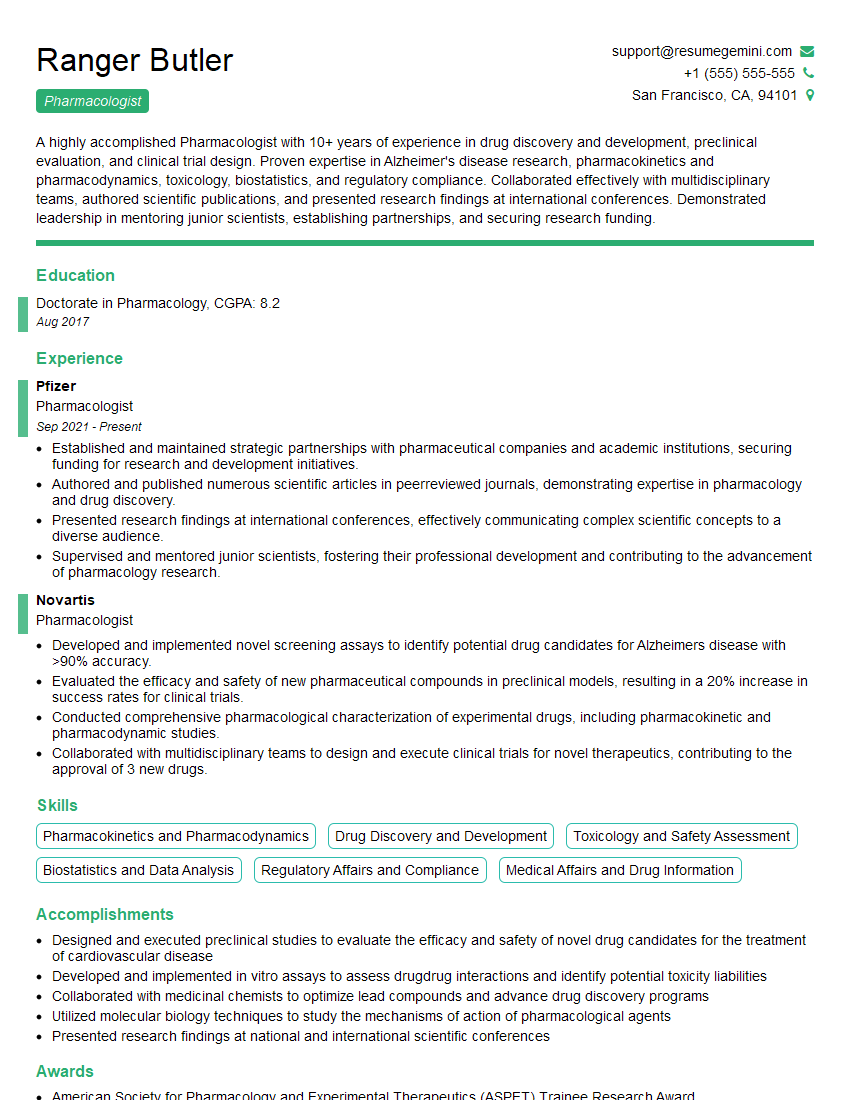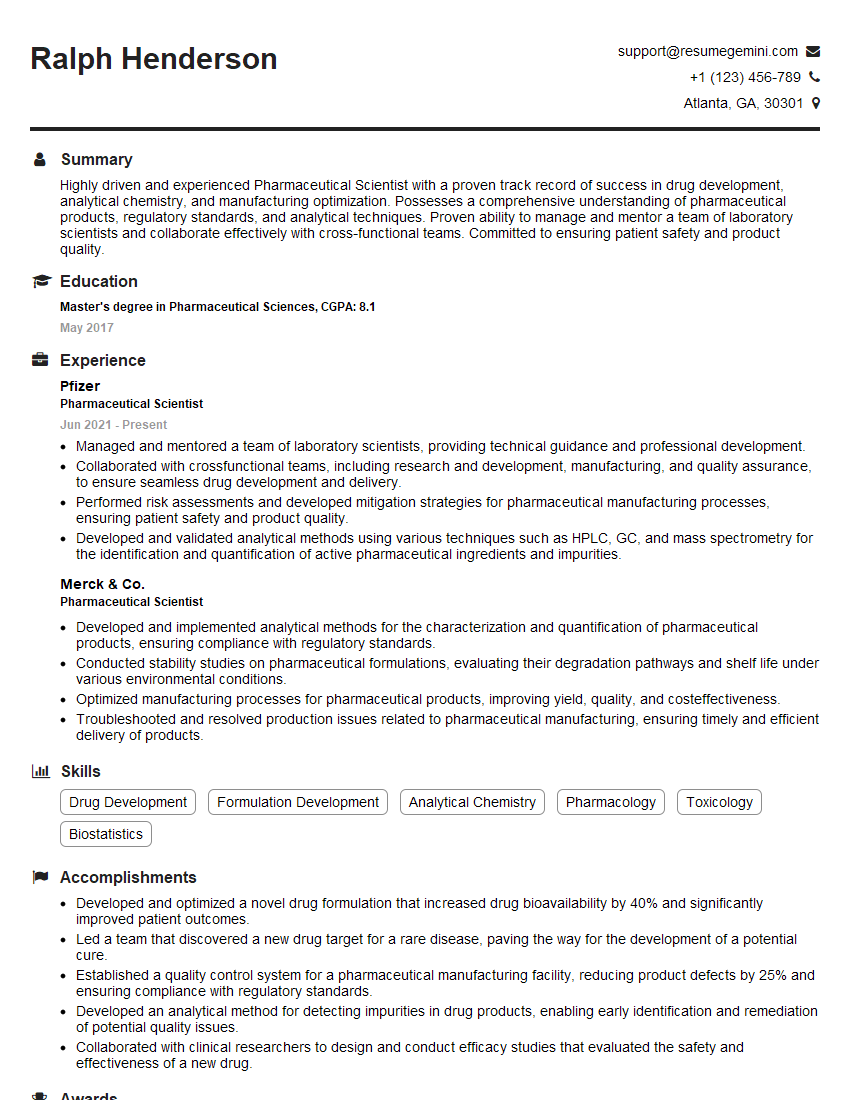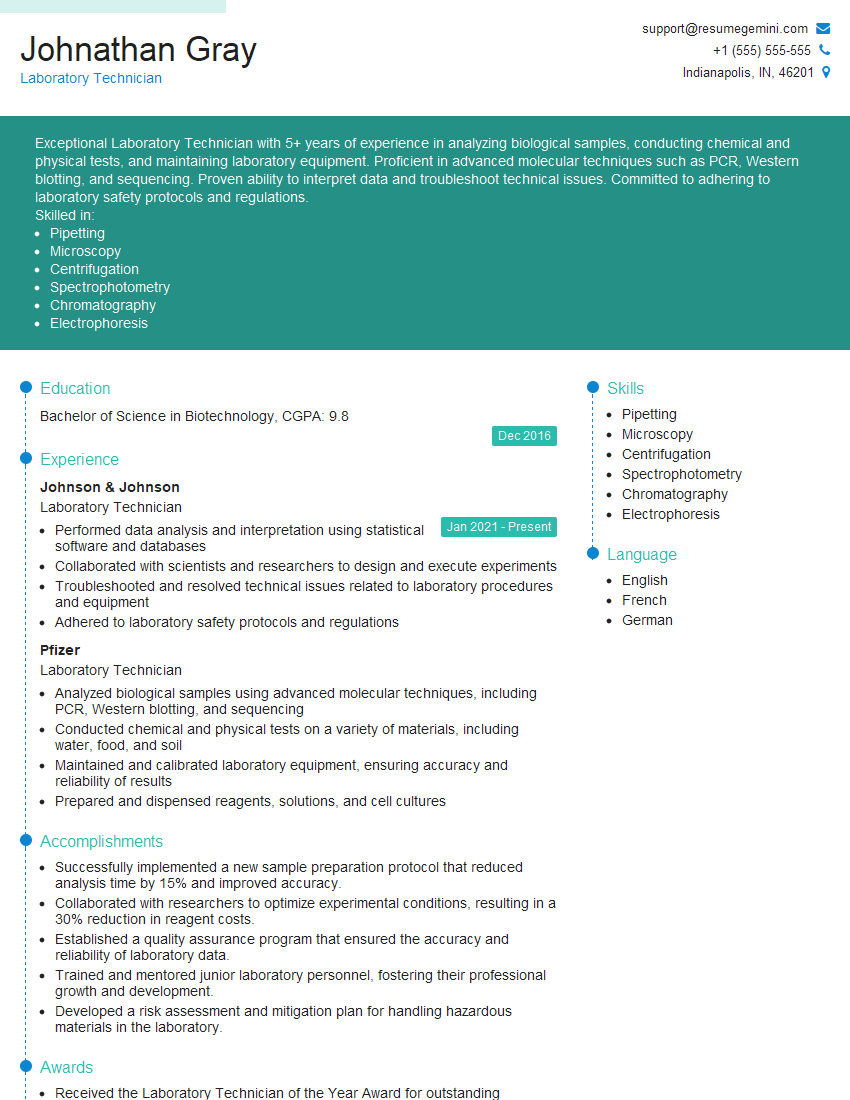The right preparation can turn an interview into an opportunity to showcase your expertise. This guide to Patch-Clamp interview questions is your ultimate resource, providing key insights and tips to help you ace your responses and stand out as a top candidate.
Questions Asked in Patch-Clamp Interview
Q 1. Describe the different configurations of Patch-Clamp techniques (whole-cell, cell-attached, inside-out, outside-out).
Patch-clamp techniques allow us to study ion channels in exquisite detail by forming a tight seal between a glass micropipette and a cell membrane. Different configurations achieve this seal and offer distinct advantages, allowing access to various aspects of membrane physiology.
- Whole-cell configuration: This is the most commonly used configuration. The membrane at the tip of the pipette is broken, creating continuity between the pipette’s interior and the cell’s cytoplasm. This allows for recording of the total membrane current and voltage, and even allows for intracellular dialysis – introducing substances into the cell. Think of it like inserting a straw into a drink and completely emptying its contents.
- Cell-attached configuration: Here, the pipette forms a tight seal with the cell membrane without breaking it. Recordings are made from a small patch of membrane under the pipette, providing access to the activity of a limited number of ion channels. Imagine it as simply placing a tiny cap over part of the drink, without affecting the rest.
- Inside-out configuration: This is achieved by carefully pulling away the pipette from the cell after forming a cell-attached patch. This exposes the cytoplasmic side of the membrane patch to the bath solution, allowing for investigation of how cytosolic factors influence channel activity. It’s like carefully removing the cap, revealing the inside for observation.
- Outside-out configuration: After forming a whole-cell patch, the pipette is pulled away, causing the membrane to reseal. This configuration exposes the extracellular side of the membrane patch to the bath solution. Similar to the inside-out configuration, it allows detailed analysis of channel function but from the perspective of the external environment. This is like inverting the cap after removing it, then observing the external surface.
Q 2. Explain the principles behind the formation of a gigaseal.
Gigaseal formation is crucial for high-quality patch-clamp recordings. It’s a high-resistance seal (typically >1 GΩ) formed between the glass micropipette and the cell membrane. This seal minimizes leakage currents, allowing for accurate measurement of the tiny currents flowing through ion channels. The seal’s formation relies on several factors:
- Surface tension: The glass pipette and cell membrane are both subject to surface tension. When the pipette is gently applied to the cell surface, these opposing forces create a very close, water-tight connection.
- Electrostatic interactions: Charged molecules in the cell membrane and glass surface attract each other, further enhancing the seal.
- Hydrophobic interactions: Lipids in the membrane also contribute to the seal by reducing the space between the pipette and cell membrane, further tightening the seal.
- Negative pressure: A small amount of negative pressure applied through the pipette can enhance seal formation by pulling the membrane onto the pipette tip.
The resulting seal isolates a very small area of membrane, ensuring accurate measurements and minimal noise in your recordings.
Q 3. What are the common challenges encountered during gigaseal formation, and how do you troubleshoot them?
Gigaseal formation can be challenging. Several factors can hinder the process:
- Cell surface contamination: Proteins or debris on the cell surface can prevent proper contact between the pipette and the membrane. Solution: Thorough cleaning of the recording chamber and using fresh cells.
- Pipette quality: A poorly polished or damaged pipette tip will impair seal formation. Solution: Careful pipette pulling and quality control.
- Incorrect pipette approach: A too rapid or forceful approach can damage the cell membrane. Solution: Gentle, slow approach to the cell.
- Insufficient suction: Gentle suction is often needed to draw the cell membrane to the pipette tip and enhance seal formation. Solution: Careful manipulation of pipette pressure.
- High pipette capacitance: A pipette with high capacitance can make it difficult to form a stable gigaseal. Solution: Using pipettes with appropriate dimensions and low capacitance.
Troubleshooting involves systematically addressing each potential problem. Visual inspection of the cell and pipette, adjusting the approach speed, and the careful control of suction are critical. Often, trial and error is necessary to master gigaseal formation.
Q 4. How do you compensate for series resistance in whole-cell recordings?
Series resistance (Rs) is the resistance of the solution between the recording electrode and the cell membrane. It acts as a filter on the recorded signals and can significantly impact the accuracy of whole-cell recordings. A high Rs value slows down the voltage changes and reduces the accuracy of the voltage clamp, affecting the measurement of current.
Compensation is crucial. We use electronic circuitry within the patch clamp amplifier to partially counteract the effects of Rs. This involves injecting a small current to compensate for voltage drops across the Rs. The amount of compensation is carefully adjusted by the user to minimize the voltage error. This involves:
- Measuring Series Resistance: A common technique involves injecting a small, fast voltage step, and then measuring the resultant current.
- Compensation Circuitry: The patch clamp amplifier uses this measurement to adjust its output, minimizing voltage errors caused by Rs.
- Monitoring Compensation: It’s crucial to continuously monitor and adjust the compensation throughout the experiment, as Rs can drift over time due to changes in cell health or electrode position.
However, overcompensation is as problematic as under-compensation and can lead to oscillations or instability.
Q 5. Explain the difference between voltage-clamp and current-clamp techniques.
Voltage-clamp and current-clamp are two fundamental modes of patch-clamp recording. They differ in their approach to controlling membrane potential and measuring ionic currents.
- Voltage-clamp: In this mode, the amplifier actively controls the membrane potential at a predetermined level, and the resulting ionic currents are measured. Think of it like setting a thermostat in a room to maintain a fixed temperature. The heater (current) will adjust automatically to meet the temperature set point (voltage).
- Current-clamp: Here, a controlled current is injected into the cell, and the resulting changes in membrane potential are recorded. In this case, we control the flow of water into a tank and observe how the water level (voltage) changes.
The choice between voltage-clamp and current-clamp depends on the research question. Voltage-clamp is ideal for studying ion channel kinetics and their voltage-dependence, while current-clamp is better suited for studying neuronal excitability and the generation of action potentials.
Q 6. Describe the Nyquist theorem and its relevance to Patch-Clamp data acquisition.
The Nyquist-Shannon sampling theorem, commonly known as the Nyquist theorem, dictates that to accurately capture a signal, the sampling frequency (how often we measure the voltage) must be at least twice the highest frequency present in the signal. In patch-clamp recordings, this is crucial because we often deal with fast ionic currents, which contain high frequency components.
For example, if we have ionic currents oscillating at a maximum of 1 kHz, we must sample at at least 2 kHz to avoid aliasing. Aliasing occurs when high-frequency components are misinterpreted as lower frequencies, leading to inaccurate data. This is like trying to capture a fast-spinning wheel using only a slow-motion camera; you might not get the correct speed and direction.
Proper application of the Nyquist theorem ensures that the recorded data accurately reflects the actual ionic currents, avoiding distortion and artifacts.
Q 7. What are the factors that affect the membrane capacitance and how is it measured?
Membrane capacitance (Cm) reflects the cell’s ability to store electrical charge across its membrane. It’s determined by the area of the membrane and the thickness of the insulating lipid bilayer. A larger membrane area or thinner bilayer increases capacitance.
- Membrane area: A larger cell has a larger surface area and hence higher Cm.
- Membrane thickness: A thinner membrane allows for easier charge accumulation, hence increasing Cm.
- Membrane composition: The dielectric constant of the membrane also plays a role.
Cm is measured by injecting a small, square-wave current pulse into the cell (through the patch pipette) and then measuring the resultant voltage response. The rising phase of the voltage response is exponential, and the time constant (τ) of this exponential function is directly related to Cm and the access resistance (Ra) which is the resistance between the pipette and the membrane. Therefore, Cm can be calculated using the formula:
Cm = τ/RaWhere τ is the time constant and Ra is the access resistance. The value of Ra is usually determined separately by performing voltage steps or by measuring it during the whole-cell break in.
Q 8. How do you identify and mitigate the effects of capacitance artifacts?
Capacitance artifacts in patch-clamp recordings arise from the capacitance of the patch pipette and the cell membrane. This capacitance acts as a capacitor, storing charge and causing a transient current whenever the voltage changes. Imagine it like filling a tiny bucket (the capacitor); it takes time to fill and empty. This transient current can obscure the actual ion channel currents we want to measure.
Mitigation strategies focus on minimizing the capacitance and its effect on the signal. We achieve this through several methods:
- Using smaller diameter pipettes: Smaller pipettes have less capacitance.
- Using high-quality amplifiers with fast compensation circuitry: Modern patch-clamp amplifiers have sophisticated circuitry specifically designed to compensate for capacitance. This involves electrically ‘canceling out’ the capacitive current, leaving behind the ionic currents of interest.
- Using appropriate filtering: Filtering removes unwanted high-frequency noise, including some of the capacitance artifact. However, we need to be careful not to filter out high-frequency components of the actual signal.
- Careful pipette fabrication and sealing: A high-resistance seal between the pipette and the cell minimizes capacitive current.
For example, if I observe a large, fast transient current at the beginning of a voltage step, and this transient decays rapidly, I would suspect a large capacitance artifact. By adjusting the amplifier’s capacitance compensation circuit, I can usually reduce or eliminate this artifact, resulting in a cleaner recording, focusing on the underlying ion channel activity.
Q 9. What are the different types of electrodes used in Patch-Clamp experiments, and what are their advantages and disadvantages?
Patch-clamp experiments employ various electrodes, each with its own advantages and disadvantages:
- Glass micropipettes: These are the most common type. They’re pulled from glass capillaries and have a very fine tip (around 1-2 µm diameter) to form a tight seal with the cell membrane. Their advantages are their versatility, ease of fabrication and low cost. However, they’re fragile and can break easily.
- Quartz pipettes: These offer improved mechanical stability and resistance to breakage compared to glass. They’re useful when working with delicate cells or requiring long recordings.
- Metal electrodes: While less common in patch-clamp, they can be used in specific applications, such as voltage-clamp experiments on large cells or tissues. Their main advantage is their high conductivity, but their stiffness can damage cells. Precise control over their tip geometry can also be more challenging.
The choice of electrode depends on the specific experimental setup and the type of cells being studied. For example, for recording from small neurons, a high-quality glass micropipette is typically preferred due to its small tip size and ability to form a high-resistance seal. But for larger cells, a quartz pipette might be a more robust option.
Q 10. Explain the concept of liquid junction potential and its implications in Patch-Clamp experiments.
The liquid junction potential (LJP) arises from the difference in ionic composition between two solutions separated by a membrane (in our case, the tip of the patch pipette and the extracellular solution). Imagine two solutions with different concentrations of salts – ions will diffuse across the interface, creating a small voltage difference. This is the LJP.
In patch-clamp, the LJP influences the measured membrane potential. It’s a small voltage, typically a few millivolts, but it can significantly impact accurate measurements, especially when studying subtle changes in membrane potential. For instance, an LJP of 2mV could be significant if measuring small ion channel currents.
We can mitigate the LJP by carefully controlling the ionic composition of the internal and external solutions, aiming for similar ionic strength and mobility. Using an agar bridge saturated with a high-concentration salt solution can also help to minimize the LJP.
Failure to account for the LJP can lead to inaccurate measurements of membrane potential and ion channel currents. Correcting for the LJP is crucial for accurate interpretation of patch-clamp data.
Q 11. How do you calibrate your Patch-Clamp setup?
Calibrating a patch-clamp setup is crucial for obtaining accurate and reliable results. This involves several steps:
- Pipette capacitance and resistance measurement: The amplifier’s capacitance compensation circuit needs to be adjusted to minimize the capacitance artifact, and the pipette resistance needs to be measured to ensure it falls within the optimal range (usually a few megaohms). It’s measured using a small voltage pulse, and the resulting current is used to calculate resistance.
- Leak current measurement: This measures the current flowing across the membrane in the absence of any open ion channels. It allows us to correct for the leakage in the analysis.
- Voltage calibration: The amplifier’s voltage output needs to be calibrated to ensure accurate measurements of membrane potential. This is typically done using a known voltage source and comparing the output reading to its known value.
- Current calibration: This involves injecting a known current and verifying the amplifier’s output to assess its accuracy in measuring the current.
Each calibration step is necessary to ensure that the signals measured reflect the actual biophysical processes of the ion channels, rather than instrument artifacts. For instance, an inaccurate voltage calibration could lead to misinterpretation of the voltage-dependent activation curves of ion channels.
Q 12. Describe the process of preparing cells for Patch-Clamp experiments.
Preparing cells for patch-clamp experiments is critical for successful recordings. The process is tailored to the cell type but generally includes:
- Cell culture and harvesting: Cells are cultured in appropriate media and then harvested using enzymatic or mechanical methods. The goal is to obtain a healthy cell population ready for electrophysiological experimentation.
- Enzymatic treatment (often): This step helps to remove extracellular matrix surrounding cells, facilitating easy access for the pipette to form a seal.
- Washing and resuspension: Cells are washed to remove residual enzymes and resuspended in a physiological solution that maintains their viability.
- Perfusion or bath solution: Cells are either continuously perfused or placed in a bath with the chosen physiological solution.
- Positioning for recording: Cells are carefully placed on a recording chamber (often a coverslip) under a microscope for patch clamping.
For example, when working with neurons, special care needs to be taken to maintain their health and minimize mechanical stress, since neurons are more fragile than many other cell types. Optimal enzymatic treatment and careful handling is critical for successful patch clamp recording from neurons. The solutions and perfusion rates are fine-tuned to maintain cell health throughout the experiment.
Q 13. What are the common causes of noise in Patch-Clamp recordings, and how can they be minimized?
Noise in patch-clamp recordings can stem from various sources, hindering accurate measurements. Common causes include:
- Thermal noise (Johnson-Nyquist noise): This is inherent in all electrical components, including resistors and amplifiers, and manifests as random fluctuations in voltage. It is inversely proportional to the pipette resistance; therefore, higher resistance pipettes often have lower noise.
- Electronic noise: This originates from electronic components in the recording setup. Shielding cables and minimizing electromagnetic interference helps reduce it.
- Motion artifacts: Vibrations or movements in the experimental setup can introduce noise. A stable setup on a vibration-isolated table is important.
- Solution noise: Imperfect solution conditions, bubbles in the solution or poor mixing can introduce noise.
Minimizing noise requires a combination of strategies:
- High-quality equipment: Using low-noise amplifiers and other components is essential.
- Electromagnetic shielding: Shielding the recording setup reduces electromagnetic interference.
- Vibration isolation: Using a vibration-isolation table stabilizes the setup.
- Careful solution preparation: Preparing solutions carefully minimizes artifacts from impurities and bubbles.
- Filtering: Appropriate filtering removes high-frequency noise without affecting the signal of interest.
For instance, if I observe high-frequency noise in my recordings, I would first check for electromagnetic interference, ensure proper grounding and shielding of the setup. I would then consider using an amplifier with better noise characteristics.
Q 14. Explain the different types of ion channels and their biophysical properties.
Ion channels are membrane proteins that selectively allow the passage of specific ions (e.g., Na+, K+, Ca2+, Cl−) across cell membranes. They are responsible for many physiological processes, including nerve impulse transmission, muscle contraction, and hormone secretion.
There’s a huge diversity of ion channels, categorized by several properties:
- Selectivity: The type of ion they allow to pass (e.g., sodium channels are selective for sodium ions).
- Gating mechanisms: How they open and close (e.g., voltage-gated, ligand-gated, mechanically-gated).
- Kinetic properties: How fast they open and close (e.g., activation and inactivation kinetics).
Examples:
- Voltage-gated sodium channels: These channels open in response to changes in membrane potential and are critical for the rapid depolarization phase of action potentials in neurons.
- Voltage-gated potassium channels: These channels open in response to changes in membrane potential and are essential for repolarization of the membrane potential after the action potential.
- Ligand-gated ion channels: These channels open when a specific ligand (e.g., a neurotransmitter) binds to them. Nicotinic acetylcholine receptors are a prominent example.
- Calcium channels: Play crucial roles in diverse cellular processes including muscle contraction, neurotransmitter release, and gene expression.
The biophysical properties of ion channels (e.g., conductance, voltage dependence, kinetics) are precisely measured using patch-clamp techniques. Studying these properties helps us to understand the fundamental mechanisms of cellular signaling and their implications in health and disease.
Q 15. Describe your experience with data analysis software for Patch-Clamp data (e.g., Clampfit, pCLAMP).
My experience with patch-clamp data analysis software is extensive, encompassing both Clampfit and pCLAMP, the industry standards. I’m proficient in all aspects, from basic data acquisition and filtering to advanced analysis techniques. For instance, with Clampfit, I’m adept at analyzing current-voltage (I-V) relationships, generating conductance-voltage (G-V) curves, and performing single channel analysis. I regularly use Clampfit’s tools for leak subtraction, capacitance neutralization, and series resistance compensation to ensure data accuracy. In pCLAMP, I’m experienced in setting up and analyzing different experimental protocols, including voltage-clamp and current-clamp configurations. Beyond these, I have experience with data analysis in other software such as Igor Pro, which is beneficial for advanced data visualization, curve fitting, and statistical analysis.
I’m comfortable with various data manipulation tasks, such as event detection, baseline correction, and averaging. I find that a deep understanding of the underlying electrophysiological principles is essential when using these tools; the software is just a means to an end – the goal is always to extract meaningful biological information.
Career Expert Tips:
- Ace those interviews! Prepare effectively by reviewing the Top 50 Most Common Interview Questions on ResumeGemini.
- Navigate your job search with confidence! Explore a wide range of Career Tips on ResumeGemini. Learn about common challenges and recommendations to overcome them.
- Craft the perfect resume! Master the Art of Resume Writing with ResumeGemini’s guide. Showcase your unique qualifications and achievements effectively.
- Don’t miss out on holiday savings! Build your dream resume with ResumeGemini’s ATS optimized templates.
Q 16. How do you interpret current-voltage (I-V) relationships obtained from Patch-Clamp recordings?
Interpreting current-voltage (I-V) relationships from patch-clamp recordings is crucial for understanding ion channel behavior. The I-V curve plots the current (I) flowing through the channel against the voltage (V) applied across the membrane. The slope of the I-V curve reflects the channel’s conductance, while the reversal potential reveals the ionic selectivity of the channel.
For example, a linear I-V relationship indicates a non-voltage-gated channel, while a non-linear relationship often suggests voltage-dependent activation or inactivation. A shift in the reversal potential upon altering the ionic concentrations in the bath or pipette solutions demonstrates selectivity to certain ions (e.g., a shift toward a more positive potential upon reducing extracellular sodium concentration demonstrates sodium selectivity).
To illustrate, a positively sloped I-V curve might indicate inward sodium currents, while a negatively sloped curve could represent outward potassium currents. Analyzing the curve’s shape, slope, and reversal potential provides insights into channel gating kinetics, ion permeability, and channel pharmacology. Moreover, I routinely use curve-fitting software to quantify these parameters objectively.
Q 17. Explain your experience with various pharmacological agents used to study ion channels.
My experience with pharmacological agents in ion channel studies is extensive. I’ve used a wide array of compounds to probe ion channel function and selectivity, including ion channel blockers and activators.
- Blockers: Tetrodotoxin (TTX) to block voltage-gated sodium channels, tetraethylammonium (TEA) to block voltage-gated potassium channels, and various other specific inhibitors like apamin (for SK channels), dendrotoxin (for Kv1 channels), and ω-conotoxin (for N-type calcium channels). The effects of these blockers are usually characterized by changes in the amplitude or kinetics of the recorded currents.
- Activators: I’ve worked with agents like 4-aminopyridine (4-AP), which activates some potassium channels. Comparing before and after application of the agent reveals changes in the channels’ behavior. For instance, a reduction in current amplitude following TTX application indicates that the recorded current is indeed carried by sodium channels.
Understanding the mechanisms of action of these drugs is crucial for correct interpretation of experimental results and for drawing biologically meaningful conclusions. In my work, I carefully control the concentration and application method of pharmacological agents to obtain reliable and reproducible results.
Q 18. How would you troubleshoot a situation where you are unable to obtain a stable gigaseal?
Failing to obtain a stable gigaseal is a common problem in patch-clamp electrophysiology. The gigaseal is the high-resistance seal (typically >1 GΩ) between the patch pipette and the cell membrane. Troubleshooting involves a systematic approach:
- Pipette Quality: Ensure the pipette is properly pulled and has a smooth tip. A poorly pulled pipette with a sharp tip can damage the cell membrane. If necessary, try different types of glass capillaries or adjusting the pipette pulling parameters.
- Pipette Solution: Check the pipette solution for air bubbles or particulate matter. These can hinder seal formation. If this is the case, filter the solution.
- Cell Health: The quality of the cells is also critical. Healthy cells are essential for forming a stable seal. Ensure the cells are healthy and appropriately prepared. Inspect under the microscope for any signs of damage or poor morphology.
- Approach and Suction: Practice your patch clamping technique. A gentle and controlled approach to the cell, and application of only minimal suction is important. Excessively vigorous suction can damage the cell.
- Electrode Potential: Verify the pipette is at the correct holding potential. If using a voltage clamp, a wrong holding potential can influence seal formation.
- Positive Pressure: A small amount of positive pressure can sometimes aid in initial membrane contact before initiating suction.
If all else fails, consider examining the perfusion system for any contaminants, or even switching to different cells or cell lines.
Q 19. How would you approach analyzing data from a patch-clamp experiment that shows unexpected results?
Unexpected results in patch-clamp experiments necessitate a thorough and systematic investigation. The first step is to carefully review the experimental protocol and identify any potential sources of error. This includes checking the integrity of the recordings, the accuracy of the data acquisition settings, and the health and viability of the cells.
Next, it’s crucial to evaluate the data for artifacts. Artifacts can arise from various sources including electrical noise, movement of the pipette, or changes in the bath solution. Careful visual inspection and analysis are crucial to distinguish between real physiological signals and artifacts.
If artifacts are ruled out, a more in-depth analysis is required. This could involve comparing the data to previous experiments, conducting control experiments, or even repeating the experiment entirely. Statistical analysis can help determine if the observed differences are statistically significant.
Finally, consider whether unexpected results might point to new and interesting biological phenomena or suggest a re-evaluation of current hypotheses. Scientific breakthroughs often arise from unexpected findings. Documenting the findings and revisiting the rationale for the study is extremely important to determine next steps.
Q 20. Describe your experience with different types of patch pipettes.
My experience includes using various types of patch pipettes, each with its own advantages and disadvantages. The choice depends on the specific experimental needs.
- Borosilicate glass pipettes: These are the most common type, offering a good balance of ease of pulling, resistance, and mechanical stability. They are suitable for most patch-clamp configurations.
- Quartz pipettes: Quartz pipettes offer improved mechanical strength and chemical inertness, making them suitable for experiments involving aggressive solutions or prolonged recordings.
- Metal-coated pipettes: These pipettes, often gold-coated, offer enhanced electrical conductivity, which may be necessary for high-frequency measurements.
The key considerations when choosing a pipette are its resistance, tip diameter, and overall quality of the pull. Higher resistance pipettes usually have smaller tip diameters, leading to better seal formation, but it can also make it harder to achieve cell attachment. The quality of the pull is vital to ensure consistent results. It is not uncommon to pull multiple pipettes in order to select the highest-quality pipette.
Q 21. What are the advantages and disadvantages of using different types of recording solutions?
The choice of recording solutions significantly impacts the outcome of a patch-clamp experiment. Different solutions are designed to control the ionic composition surrounding the cell, allowing the researcher to manipulate the driving force for ion currents and study the channels’ properties.
- Internal (pipette) solution: This solution fills the pipette and contacts the cell’s cytoplasm. The choice of internal solution often aims to control the intracellular ionic concentrations while minimizing interference with the ions of interest. For example, intracellular solutions might be designed to remove or reduce the concentration of an ion that could obscure the study of a different ion’s current.
- External (bath) solution: The external solution surrounds the cell, mirroring, as closely as possible, the physiological conditions. Modifications to this solution are essential to test the ion selectivity of the channels, as this is done by changing the concentration of one ion type and observing its influence on recorded currents.
Advantages and Disadvantages: Choosing a specific solution is a tradeoff. For example, using high concentrations of certain ions may enhance the signal but could also induce undesired effects on channel function or the cell’s physiology. Similarly, solutions optimized for a certain type of ion might not be optimal for another, and this must be factored into the experimental design. Therefore, a deep understanding of the properties of the ionic solution and its effects on ion channels is critical for accurate interpretation of the recorded data.
Q 22. How do you ensure the accuracy and reliability of your Patch-Clamp data?
Ensuring accurate and reliable Patch-Clamp data requires a multi-faceted approach, starting from meticulous experimental design to rigorous data analysis. It’s like baking a cake – you need the right ingredients and precise measurements to get a perfect result.
High-Quality Equipment Calibration: Regular calibration of the amplifier, pressure system, and other components is crucial. Drift in the amplifier can introduce significant errors in current measurements. We use established protocols and traceable standards for calibration.
Cell Health and Preparation: The health and preparation of the cells are paramount. Using healthy cells and appropriate solutions minimizes artifacts. We optimize enzymatic digestion and carefully control the environment to minimize cell stress. For example, we use specific buffer solutions optimized for the type of cell being studied.
Giga-seal Formation: A high-resistance seal (GΩ) is essential. We carefully control the pipette approach and use gentle suction to achieve this. A poor seal leads to noisy recordings and inaccurate current measurements. We monitor the seal resistance continuously to identify and avoid problems.
Data Acquisition and Analysis: We use specialized software for data acquisition and analysis. This allows for filtering, artifact correction, and statistical analysis. Using appropriate filtering techniques is vital to remove noise and highlight real signals. We always visually inspect the data for any anomalies before analysis.
Control Experiments: We always include control experiments to account for potential artifacts or non-specific effects. For instance, we perform experiments in the absence of specific drugs or treatments to establish a baseline.
Blind Analysis: To avoid bias, we often perform blind analysis where the identity of the experimental group is unknown during data analysis.
Q 23. Explain your understanding of the limitations of Patch-Clamp techniques.
Patch-clamp, while powerful, has inherent limitations. Think of it as a highly precise microscope – it provides incredible detail but has a limited field of view.
Sampling Bias: Patch-clamp studies individual cells. Results might not always be representative of the entire cell population due to variability in cell properties. It is essential to study a sufficient number of cells.
Cell Stress and Artifacts: The process of forming the patch-clamp seal can stress cells, leading to changes in their properties. Artifacts such as capacitive currents and noise can contaminate the data requiring careful filtering and analysis.
Limited Temporal and Spatial Resolution: While modern techniques improve resolution, it still takes time to obtain a recording, limiting the capture of very fast events. The technique is also spatially localized to a single patch.
Cell Type Specificity: The technique is often challenging to apply to certain cell types, for example, very small cells or those with fragile membranes. This may limit the application range.
Technical Expertise: Patch-clamp requires significant technical skill and experience. It’s not a technique that can be easily mastered.
Q 24. What are some advanced Patch-Clamp techniques that you are familiar with?
Beyond the basic whole-cell and perforated-patch configurations, several advanced techniques significantly broaden the capabilities of patch-clamp.
Fast Voltage-Clamp Techniques: These allow for accurate measurements of very fast ionic currents, revealing important kinetic information about ion channels. This requires careful control of the voltage waveform and high-bandwidth recording equipment.
Single-Channel Recording: This technique allows for the study of the activity of individual ion channels, providing insights into channel gating mechanisms and function. It requires very high seal resistances and advanced signal processing.
Simultaneous Patch-Clamp Recordings: This enables the study of interactions between cells or the activity of multiple channels in one cell simultaneously. This is challenging but incredibly informative.
Patch-Clamp Combined with Fluorescence Imaging: This powerful technique allows for the correlation of electrophysiological recordings with changes in intracellular calcium concentration or other fluorescent signals. It provides comprehensive information about the cell’s electrical and biochemical activity.
Automated Patch-Clamp Systems: These systems automate various stages of the patch-clamp process, increasing throughput and reducing variability. This is extremely useful for high-throughput screening.
Q 25. Describe a challenging Patch-Clamp experiment you performed and how you overcame the difficulties.
I once faced significant challenges while studying a specific potassium channel in a highly sensitive neuronal cell line. The cells were notoriously fragile, making it difficult to achieve a stable giga-seal. Initial attempts resulted in extremely noisy recordings, making data interpretation impossible.
To overcome this, I systematically addressed each potential source of error. I optimized the enzymatic digestion protocol to minimize cell damage and employed a softer aspiration approach during seal formation. I also carefully tested different pipette solutions and used specialized pipette pullers to achieve better tip geometry. Ultimately, by meticulously controlling temperature and using a vibration isolation table, I improved stability significantly. The successful recordings then revealed novel insights into the channel’s gating mechanism.
Q 26. Explain your understanding of the ethical considerations related to animal research in Patch-Clamp experiments.
Ethical considerations in animal research using Patch-Clamp are paramount. Our guiding principle is the 3Rs: Replacement, Reduction, and Refinement.
Replacement: We actively seek alternatives to animal models whenever possible, such as using cell lines or computer models. However, many aspects of neuronal function are uniquely complex in animal models.
Reduction: We minimize the number of animals used by employing rigorous experimental design and statistical analysis. We carefully calculate the number of animals needed to achieve statistically significant results.
Refinement: We strive to minimize animal suffering by optimizing experimental procedures to cause minimal stress and discomfort. This includes using appropriate anesthetics and analgesics and providing humane post-operative care. We closely follow all institutional and national regulations and guidelines.
Each experiment undergoes careful ethical review by an Institutional Animal Care and Use Committee (IACUC) to ensure compliance with all ethical standards.
Q 27. How do you maintain and clean your Patch-Clamp equipment?
Maintaining and cleaning patch-clamp equipment is critical for reliable and long-lasting performance. It’s a bit like maintaining a high-precision instrument – regular care is key.
Regular Cleaning: After each experiment, the pipette holder, recording chamber, and other components are thoroughly cleaned using appropriate solutions to remove salts and cellular debris. This prevents contamination and ensures a long lifetime of the equipment.
Pipette Cleaning: Pipettes are made from borosilicate glass and must be cleaned thoroughly and correctly after use. We use a mixture of appropriate cleaning agents, such as solutions for protein removal and rinsing with distilled water and ethanol, followed by oven drying.
Headstage Maintenance: The headstage is a sensitive component and needs regular inspection to identify potential issues before they occur. This involves checking for any physical damage, loose connections, and cleaning the connectors.
Amplifier Calibration: The amplifier is calibrated regularly following manufacturer recommendations. Any deviations from specifications are documented and addressed as needed.
Software Updates: Patch-clamp software is frequently updated. This ensures compatibility with hardware and access to the latest features and bug fixes.
Preventative Maintenance: Regular preventative maintenance schedules are followed to catch and correct minor issues before they escalate and prevent the failure of vital components.
Key Topics to Learn for Patch-Clamp Interview
- Basic Patch-Clamp Techniques: Understand the different patch clamp configurations (cell-attached, whole-cell, inside-out, outside-out) and their applications. Be prepared to discuss the advantages and limitations of each.
- Electrophysiology Fundamentals: Demonstrate a strong grasp of membrane potential, ion channels, current-voltage relationships, and the principles of electrical signaling in cells.
- Data Acquisition and Analysis: Familiarize yourself with the process of acquiring, analyzing, and interpreting patch-clamp data. This includes understanding noise reduction techniques and common data analysis software.
- Experimental Design and Troubleshooting: Be ready to discuss experimental design considerations, potential sources of error in patch-clamp experiments, and effective troubleshooting strategies.
- Specific Ion Channels and their Roles: Develop a solid understanding of the function and properties of various ion channels relevant to your research area. Be prepared to discuss specific examples and their physiological significance.
- Pharmacology and Drug Effects: Understand how drugs and toxins affect ion channel activity and how this can be studied using patch-clamp techniques.
- Advanced Patch-Clamp Techniques: (Optional, depending on experience level) Explore more advanced techniques such as perforated patch, fast perfusion, and single-channel recording.
Next Steps
Mastering Patch-Clamp techniques significantly enhances your career prospects in neuroscience, pharmacology, and related fields, opening doors to exciting research opportunities and collaborations. To maximize your chances of landing your dream role, it’s crucial to present your skills and experience effectively. Creating an ATS-friendly resume is paramount in getting your application noticed. ResumeGemini offers a powerful resource to build a professional resume that highlights your expertise in Patch-Clamp. We provide examples of resumes tailored specifically to this field to help you showcase your qualifications convincingly. Take advantage of this valuable tool to elevate your job search and secure your next exciting career opportunity.
Explore more articles
Users Rating of Our Blogs
Share Your Experience
We value your feedback! Please rate our content and share your thoughts (optional).
What Readers Say About Our Blog
Interesting Article, I liked the depth of knowledge you’ve shared.
Helpful, thanks for sharing.
Hi, I represent a social media marketing agency and liked your blog
Hi, I represent an SEO company that specialises in getting you AI citations and higher rankings on Google. I’d like to offer you a 100% free SEO audit for your website. Would you be interested?
